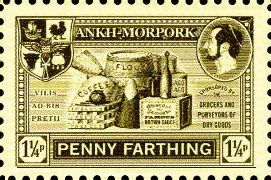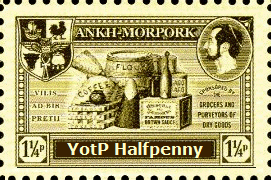|
Humble and almost over familiar, this stamp probably comes first in any Discworld stamp listing or album. Does it have anything of interest to offer collectors? Judge for yourself.
From the outset the lowest denomination stamp from the original issue was going to feature the Ankh-Morpork Post Office building, and would be the smallest stamp. And it would be orange-red. Below is perhaps the earliest image of the stamp under development, courtesy the History of Discworld Stamps poster, and showing the familiar single point perspective view of the post office. Note the proportions of the stamp at the time. It is twice as wide as tall, whereas the issued stamp had a ratio of 1.6:1 Conspicuous are the statues of two dachshunds on the steps. Apparently Terry Pratchett wanted these included, as postmen fear this breed more than any other; they can be irritable and go for the ankles. Actually if a bit smaller they would make good bootscrapers, essential I would imagine in Ankh-Morpork. Notice how few floors the building had at the time. That would soon change. The AMPO motto is present across the top of the building but it is not possible to detect whether the HUGOS letters are missing.
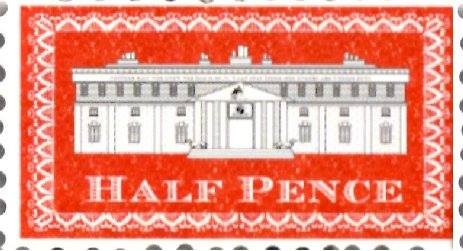
|
The changes in the drawing of the building illustrates how early in the development of Going Postal that stamps were conceived. The post office building was described by Terry for the drawing of the stamp above, but as the plot began to develop it became apparent that the building needed to have more floors. So a redrawing was needed. These two images show developments of the stamp with the extra storeys. Apologies for the lack of clarity on these images - they may be scans of scans of whatever. Despite the small size, there is still a wealth of detail to be seen on these stamps, but it is interesting to see the experimentation of putting a pale value on a reddish background compared to a red value on a paler background. Despite the stamp’s proportions the design is close to the issued stamp.
|
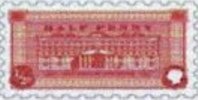
|
|
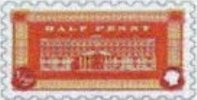
|
|
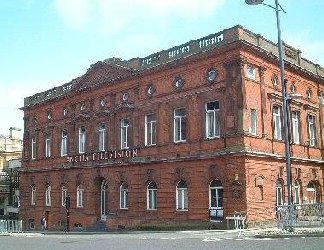
It has been suggested that artist Alan Batley used Norwich’s former Agricultural Hall as the model for the sketch. There are many similarities, but most UK towns will have such a building. It was erected 1882, and designed by architect John Bond Pearce. However its location makes this the best candidate, even if it lacks the grand columned entrance. Ironically the old post office is next door, and the impressive entrance to that may have been transplanted onto the sketch of the Agricultural Hall.
All the AMPO halfpenny definitives, over the years, have had the motto "Neither snow nor rain nor heat nor gloom of night can stay these messengers about their duty” included - with or without the missing letters. Terry used what is commonly thought to be the motto of the US Post Office and modified it. Was this because here was concerned about copyright? Perhaps, but the original is not official, and is a quote from the Greek philosopher Herodotus (who is a bit too old to sue). The original YotP stamps have O G H S and U missing, but following the narrative of the story, they get replaced on stamps from later years.
The last stage in the stamp’s development was the resizing to the familiar 21 mm by 33 mm. It had been arranged that Waterstones would have a commemorative cover as a bonus with the first book sales, and the halfpenny to twenty pence definitives used. The Dutch security printing firm Enschede was chosen to produce the stamps for the covers, while the rest of the order would be sold through the Discworld Emporium. Enschede use a comb perforating technique where the entire sheet is perforated in one process with the perforations meeting exactly at the corners of the stamps. For this they have a range standard sizes; they cannot cope with odd dimensions. The Halfpenny stamp was the one that required most adjustment to fit one of Enschede’s templates. It looks like part of the horizontal framing had to be removed, with more added vertically. The central image would have then been scaled to fit the resultant space.
All values of the first definitives were printed in miniature sheet format using gummed paper as a final check on print quality. The Halfpenny was printed as a block of four.
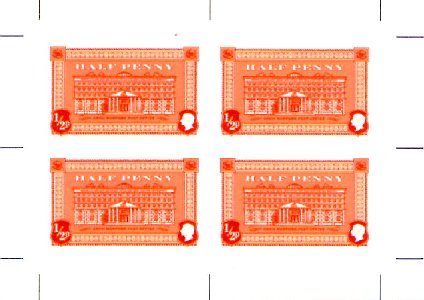
|
